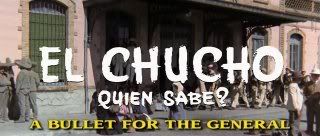
PLOT:
Set during the Mexican Revolution, Damiano Damiani’s A Bullet for the General follows the bandit leader El Chucho (Gian Maria Volonte, best known as the bad guy from a couple of Leone Westerns) and his gang of thieves, as they raid trains and government facilities for guns and ammunition to sell to General Elias, who is either a Zapatista rebel or a stand-in for Zapata himself (I’m not sure which). Chucho allows a gringo named Bill Tate (whom Chucho dubs “Niño”) to join the gang, unaware that Tate is actually an assassin hired by the Mexican government to take out General Elias with a golden bullet.
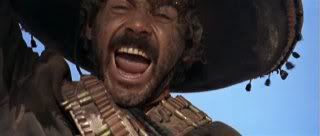
REVIEW:
Without meaning to be reductive, the most important parts of a film are probably the beginning and the end. If you can catch people’s attention at the start, and wow them at the finish, you’ve probably got a good movie on your hands, unless you really duff it in the middle. Damiani’s political Western A Bullet for the General has one of the best first 20 minutes in film history.
It begins with four men, in close up, walking along a plain white wall. They are outside, and seem to be in a bit of a hurry. They stop, and two of them hug. And then the camera cuts away, revealing that these four are bracketed by soldiers, and that a row of men are aiming their rifles. It’s an execution by firing squad, and as Tate (Lou Castel) looks on, the four are gunned down. Tate is obviously out of place--he is pale and fair-haired, clean and well-dressed. He doesn’t belong.
Unfazed by the execution, Tate walks over to the train station to buy a ticket. A small Mexican boy asks him if he’s an American, and then asks him if he likes Mexico.
“Not very much,” Tate responds.
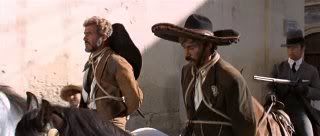
The film jumps straight into the action when the train is attacked by Chucho’s gang. The setup is clever: they’ve basically crucified a captain of the army, placing him on the tracks. When the train stops, unwilling to crush the still-living officer, the bandits attack. A lieutenant on the train shouts at the captain, asking for orders. The captain lets it be known that the train should just move forward. The lieutenant, unwilling to let the captain die by his command, instead drops down between the tracks and tries to crawl up to the officer, hoping to free him without bloodshed. Chucho shoots the lieutenant in the guts. Then the train rolls forward, crushing the captain.
Tate, seeing his opportunity, kills the engineer, stopping the train for the bandits. He tells Chucho that he’s an outlaw, and that he was being extradited to the US to face trial. He asks if he can join Chucho’s band. Chucho agrees, giving Tate a new name, Niño (“boy”).
The opening scenes, then, go a long way to set up the movie in a concise and powerful manner. Chucho and Niño are obviously both ruthless individuals; they share a love of money and of violence that unites them, even though they are completely dissimilar in every other way. It’s clearly not going to be a story about heroes.
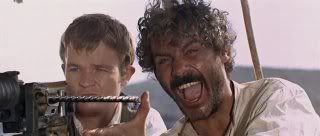
Now a part of the gang--including Chucho’s obsessively religious brother, El Santo (Klaus Kinski) and the charming bandita Adelita (Martine Beswick)--Niño aids the bandits as they raid government buildings in search of guns. Niño is willing to help, but he’s impatient, always pestering Chucho about meeting the General. Chucho, not the brightest bandito around, seems to take it in stride, and is only angered when Niño convinces the other men to abandon Chucho and his brother when the two of them are more interested in helping poor villagers than making money. Still, Chucho’s noble streak doesn’t last long--he, too, is in it for the pesos--and soon the gang is back together again, in time for the film’s climax.
Volonte’s Chucho is fascinating to watch; he’s wild and charismatic, and defies easy explanation, probably because Chucho himself is quite a conflicted character. There’s something inside of him--probably his background as a poor peasant--that connects him with the people, but any sort of kindness or generosity of his character is often obfuscated by his greed and rude manners. He distrusts wealth and learning and yet clearly envies it. He has to tell his brother Santo that they are giving the guns to General Elias, too embarrassed to admit that he’s selling them. That Niño is an assassin should be obvious to Chucho, and so it’s easy not to feel sorry for him, but his genuine humanity, no matter how disfigured, makes you side with the bandit against the cold, professional gringo.
Against the expectations of the genre, A Bullet for the General features a couple of strong female characters. Little is made of the fact that the first of these, Adelita, fights side-by-side with the rest of the bandits, just as though she were a man. She is clearly attracted to Niño, but her relationship with one of the other bandits keeps them apart, for a time. Adelita makes it known that she has suffered at the hands of the government and the wealthy landowners; she, more than any of the other bandits, is motivated by hatred.
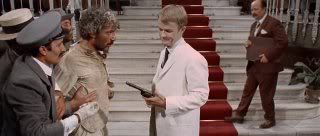
The role of Rosario is much smaller, but is a vital part of the story. When the bandits and a handful of poor, angry townsfolk come to the home of the wealthy landowner Don Feliciano, it is his wife, Rosario (Carla Gravina) who tries to deal with the situation. We watch, uncomfortably, as she tries to reason with bandits, and then moves on to threats, before breaking down completely when it’s clear that her husband will be killed. While Chucho and his men have hardly been forgiving of their military targets, this is the first time that they victimize the unarmed and the helpless. Our sympathy for Chucho is tested when he even agrees to let his men rape Rosario--an action which Niño puts a stop to.
The man who adapted the screenplay for A Bullet for the General, Franco Solinas, was a politically-interested writer with leftist sympathies. This is obviously most evident in his interest in the Mexican Revolution, which is not a neutral setting for the story, but an integral one. Clearly this is a man who sides with the Revolution. Though quick to show the ugliness of the bandits and revolutionaries, he and the director are at their most heavy-handed with the repeated use of gold as a symbol for capital and wealth. It is not a simple affectation, that Niño must shoot the General with a golden bullet--but at least that bit of imagery is acceptable. Harder to swallow is the existence, and importance, of a golden machine gun, a mechanized weapon capable of unlimited slaughter and linked to wealth and privilege by its ostentatious decoration. Even if there were some historic truth to it--even if there is documentation proving the existence of a golden machine gun during the Revolution--it’s simply too hard to swallow as a practical or realistic detail. It takes you out of the film, smacking you in the face with its inauthenticity.
That said, A Bullet for the General is one of the best Westerns I’ve ever seen, a real gem, and I’d encourage anyone to track it down and give it a try. While I’m not familiar with Damiani’s other films, this one certainly gives Leone a run for his money.

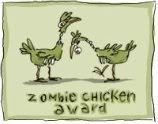








1 comment:
I love this movie. Its brilliant. The only flaw is that Lou Castel is in it, probably THE worst actor in the world.
Post a Comment